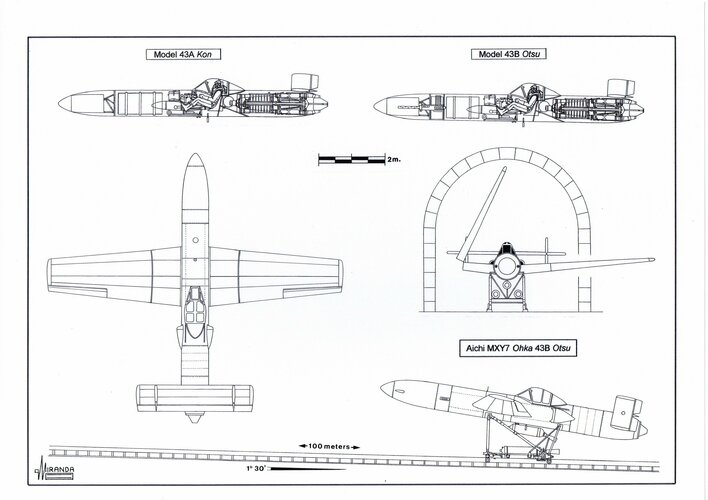- Yes
- No

History
In 1952 a partial ban on aircraft research in Japan was lifted, which made it possible for domestically designed aircraft to be produced in Japan. By the spring of 1954 the Defence Agency of Japan had developed a plan to develop a training jet aircraft with potential to act as an emergency fighter, this plan resulted in the Fuji T-1.
The T-1 was the first domestically designed jet aircraft produced in Japan since WW2 and Japans first domestically designed swept wing jet design. Design of a locally produced jet engine did not come soon enough, resulting in the first series of T-1s to be produced with the British Bristol Siddeley Orpheus Mk 805 turbojet engine and was designated the T-1A. The first prototype T-1 made it’s first flight on January 19 1958, with the first T-1s entering service in 1960. Once locally produced engines were available production switched to the Ishikawajima-Harima J3-IHI-3 turbojet engine, with these aircraft known as the T-1B. Some aircraft were later converted to use the Ishikawajima-Harima J3-IHI-7 engine, with these called T-1C. The Japanese engines were noticeably less powerful than the British engines. 46 T-1As and 20 T-1Bs were produced. The last T-1 was retired on March 3, 2006 with the introduction of the T-4 trainer.
The aircraft only ever acted in the training role and were usually fitted with 2 sabre-type twin-fin drop-tanks, however they had the capabilities of carrying 12.7mm gunpods, bombs or AIM-9B Sidewinders. They also had a 12.7mm browning M53-2 machine gun mounted in the nose. The F-86 influence is clear, but the T-1 is a unique vehicle in every right.
Specifications
General characteristics
- Crew: 2
- Length: 12.12 m (39 ft 9 in)
- Wingspan: 10.49 m (34 ft 5 in)
- Height: 4.08 m (13 ft 5 in)
- Wing area: 22.22 m2 (239.2 sq ft)
- Aspect ratio: 4.96:1
- Airfoil: K-561/K-569
- Empty weight: 2,420 kg (5,335 lb)
- Gross weight: 4,150 kg (9,149 lb) clean
- Max takeoff weight: 5,000 kg (11,023 lb) (with external tanks)
- Fuel capacity: 1,400 L (308 Imp Gallons)
- Powerplant: 1 × Bristol Siddeley Orpheus Mk 805 turbojet, 18 kN (4,000 lbf) thrust
Performance
- Maximum speed: 925 km/h (575 mph, 499 kn) at 6,100 m (20,000 ft)
- Cruise speed: 620 km/h (390 mph, 330 kn) at 9,150 m (30,000 ft)
- Range: 1,300 km (810 mi, 700 nmi) (internal fuel)
- Ferry range: 1,950 km (1,210 mi, 1,050 nmi) (external tanks)
- Service ceiling: 14,400 m (47,200 ft)
- Rate of climb: 33 m/s (6,500 ft/min)
- Thrust/weight: 0.43
Armament
-
Guns: Provision for 1 × 12.7 mm [Browning M53-2 machine gun in nose
-
Hardpoints: 2, with provisions to carry combinations of:
-
Missiles: 2 x AIM-9B Sidewinder Air to Air Missiles
-
Bombs and unguided rockets:
- 2 x 100 lb bombs (type?)
- 2 x 250 lb bombs (type?)
- 2 x 500 lb bombs (type?)
- 2 × 750 lb M117 bombs
- 2 x Napalm bomb (type?)
- 2 x 5-inch HVAR
- 2 x seven 2.75-inch mighty mouse FFAR on M-3 (MA-3) adaptor
- 2 x two 2.75-inch Might mouse on Ma-2 Adaptor- 2 x 2.25-inch SCAR on A-1 adaptor
-
Other: 2 × 455 L (100 Imp Gallon) drop tanks
In game
The T-1 could help to fill up tier 5 Japan, which is lacking in comparison to other nations. It’s variable load-outs make it quite an interesting aircraft, however more bombs or AAM will brings it’s gunload down to a measly single 12.7mm, making your choice of weaponry important! With so many bomb options it has potential to be a very potent CAS aircraft, or a bomb-sled. In the past the lack of guns, paired with it’s reasonable swept-wing performance stopped this aircraft from being added to the game due to balance issues, however with the event of AAM, I now think this plane could be quite competitive at the b.r. where AAM missiles first appear (think SAAB 105!). The second pilot also adds an advantage.
There is potential for up to 6 variants to be added, which could possibly replace the fictional R2Y2s and/or create potential event/premium aircraft.
T1F1
One Prototype powered by a Nippon J3
T1F2
Two prototypes, powered by 11,800 N (2,645 lbf) Bristol BOr.1 Orpheus
T1F3
Initial designation for the production T-1A, powered by 11,765.55 N (2,645 lbf) [Bristol BOr.4 Orpheus
T-1A
Powered by a 17.79 kN (4,000 lbf) Bristol Siddeley Orpheus Mk 805 turbojet engine. The original designation was T1F3. 46 built.
T-1B
Powered by an 11.77 kN (2,645 lbf) Ishikawajima-Harima J3-IHI-3 turbojet engine. 20 built.
T-1C
Converted to 13.72 kN (3,085 lbf) Ishikawajima-Harima J3-IHI-7 engines.
I am suggesting the T-1A as it was the most produced variant, and has the most powerful engine, however the T-1B and T-1C used Japanese engines, and therefore are more Japanese, in a way. It could also be argued that the later variants are better suited to their engines, as the T-1 was originally designed to have these engines. I am unfortunately not an aircraft engineer, so I can’t comment much! Ideally I’d love to see multiple variants added.
Sources
[3.0] Naval Sabres & Foreign Sabres
The phoenix from the ashes: the Fuji T-1A, Japan's first post-war jet - 1/72 Platz - iModeler
Aviation Museums | J-HangarSpace: Information on Japanese Aviation
Japanese T-1 trainer project | Secret Projects Forum
I really want this book, but I can’t read Japanese so I’m not sure if it’s worth it for me. I am sure if someone here does read Japanese and has an interest in the Fuji T-1 then it’ll be worth it for them
Thanks for reading :)



































